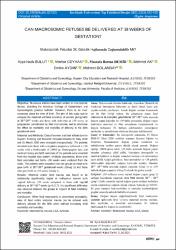| dc.contributor.author | Bulut, Ayça Nazlı | |
| dc.contributor.author | Ceyhan, Venhar | |
| dc.contributor.author | Demir, Mustafa Bertan | |
| dc.contributor.author | Ak, Mehmet | |
| dc.contributor.author | Aydın, Emine | |
| dc.contributor.author | Dolanbay, Mehmet | |
| dc.date.accessioned | 2023-03-28T12:12:37Z | |
| dc.date.available | 2023-03-28T12:12:37Z | |
| dc.date.issued | 2021 | en_US |
| dc.identifier.citation | Bulut, A. N., Ceyhan, V., Demir, M. B., Ak, M., Aydın, E. ve Dolanbay, M. (2021). Can macrosomic fetuses be delivered at 38 weeks of gestation? Kırıkkale University Medical Journal, 23(3), 422-428. https://dx.doi.org/10.24938/kutfd.857325 | en_US |
| dc.identifier.issn | 2148-9645 | |
| dc.identifier.uri | https://dx.doi.org/10.24938/kutfd.857325 | |
| dc.identifier.uri | https://hdl.handle.net/20.500.12511/10732 | |
| dc.description.abstract | Objective: Numerous articles have been written on macrosomic fetuses, including the American College of Obstetricians and Gynecologists practice bulletin. However, there is no clear consensus about the time of birth. The aim of this study was to compare the maternal and fetal outcomes of women giving birth at 38+0-38+6 weeks and those with deliveries at ≥39 weeks in pregnancies complicated by fetal macrosomia, and to determine the effect on morbidity and mortality of delivery in the 38th gestational week.Material and Methods: Data of women and their infants born in Kayseri Training and Research Hospital between 01 May 2018 and 31 March 2020 were analyzed retrospectively. The patients included were those with a singleton pregnancy delivered at ≥38 weeks with a birthweight of ≥4000 gr. Demographic data and medical history and birth outcomes of the patients were recorded from the hospital data system. Multiple pregnancies, those with fetal anomalies and births <38 weeks were excluded from the study. The patients were separated into two groups as those who gave birth at 38+0-38+6 gestational weeks (Group 1) and those who gave birth at ≥39 weeks (Group 2).Results: Maternal and/or fetal trauma was found to be statistically significantly higher in nulliparous women with vaginal delivery ≥39 weeks compared to those with vaginal delivery at 38+0-38+6 weeks (p=0.017). No significant difference was observed between the groups in respect of fetal morbidity and mortality.Conclusion: When fetal macrosomia is determined antenatally, rates of fetal and/or maternal trauma can be reduced with delivery planned for the 38th week without increasing fetal morbidity and mortality. | en_US |
| dc.description.abstract | Amaç: Makrozomik fetüsler hakkında, Amerikan Obstetrik ve Jinekoloji Derneğinin bültenleri de dahil olmak üzere çok sayıda makale yazılmıştır. Ancak doğum zamanı konusunda net bir fikir birliği yoktur. Bu çalışmanın amacı fetal makrozomi ile komplike gebeliklerde 38+0-38+6 hafta arasında doğum yapan kadınlar ile ≥39 hafta sonrasında doğum yapan kadınların maternal ve fetal sonuçlarını karşılaştırmak ve doğum haftasının 38. haftaya çekilmesinin yenidoğanın morbidite ve mortalitesini etkileme düzeyini belirlemektir.Gereç ve Yöntemler: Bu retrospektif çalışmada, 01 Mayıs 2018-31 Mart 2020 tarihleri arasında Kayseri Eğitim ve Araştırma Hastanesinde doğum yapan kadınların ve bebeklerinin verileri geriye dönük olarak tarandı. Doğum ağırlığı ≥4000 gram, tekil, ≥38 hafta üzerinde doğum yapan hastalar çalışmaya dâhil edildi. Hastaların demografik ve medikal öyküleri ve doğum sonuçları hastane veri sisteminden kayıt edildi. Çoğul gebelikler, fetal anomaliler ve <38 gebelik haftasındaki doğumlar çalışma haricinde tutuldu. Hastalar 38+0- 38+6 hafta arasında doğum yapanlar (Grup 1) ve ≥39 haftada doğum yapanlar (Grup 2) olarak iki gruba ayrıldı.Bulgular: ≥39 haftadan sonra vajinal doğum yapan (grup 2) nullipar kadınlarda maternal veya fetal travma 38+0 - 38+6 (grup 1) hafta arasında vajinal doğum yapan nullipar kadınlara oranla istatistiksel anlamlı olarak yüksek bulundu (p=0.017). İki grup arasında fetal morbidite ve mortalite incelendiğinde gruplar arasında anlamlı farklılık izlenmedi.Sonuç: Doğum öncesi değerlendirmede fetal makrozomi saptanan gebelerde fetal ve/veya maternal travma oranları, fetal morbidite ve mortalite arttırılmadan 38. haftada planlanacak bir doğum ile azaltılabilir. | en_US |
| dc.language.iso | eng | en_US |
| dc.publisher | Kırıkkale University | en_US |
| dc.rights | info:eu-repo/semantics/openAccess | en_US |
| dc.subject | Macrosomia | en_US |
| dc.subject | Trauma | en_US |
| dc.subject | LGA | en_US |
| dc.subject | Dystocia | en_US |
| dc.subject | Makrozomi | en_US |
| dc.subject | Travma | en_US |
| dc.subject | LGA | en_US |
| dc.subject | Distosi | en_US |
| dc.title | Can macrosomic fetuses be delivered at 38 weeks of gestation? | en_US |
| dc.title.alternative | Makrozomik fetuslar 38. gebelik haftasında doğurtulabilir mi? | en_US |
| dc.type | article | en_US |
| dc.relation.ispartof | Kırıkkale University Medical Journal | en_US |
| dc.department | İstanbul Medipol Üniversitesi, Tıp Fakültesi, Cerrahi Tıp Bilimleri Bölümü, Kadın Hastalıkları ve Doğum Ana Bilim Dalı | en_US |
| dc.authorid | 0000-0001-8877-2803 | en_US |
| dc.identifier.volume | 23 | en_US |
| dc.identifier.issue | 3 | en_US |
| dc.identifier.startpage | 422 | en_US |
| dc.identifier.endpage | 428 | en_US |
| dc.relation.publicationcategory | Makale - Ulusal Hakemli Dergi - Kurum Öğretim Elemanı | en_US |
| dc.identifier.doi | 10.24938/kutfd.857325 | en_US |
| dc.institutionauthor | Aydın, Emine | |
| dc.identifier.trdizinid | 507911 | en_US |


















